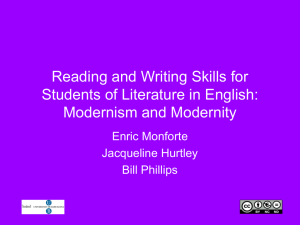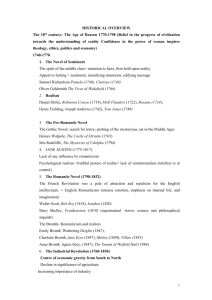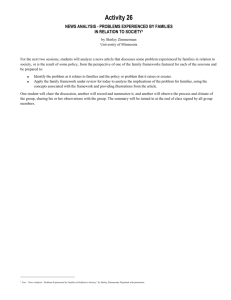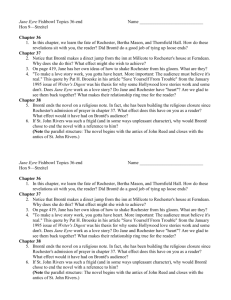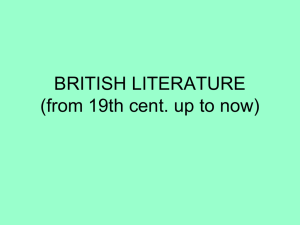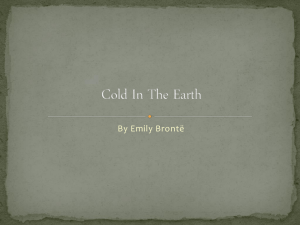Tess and Wuthering Heights
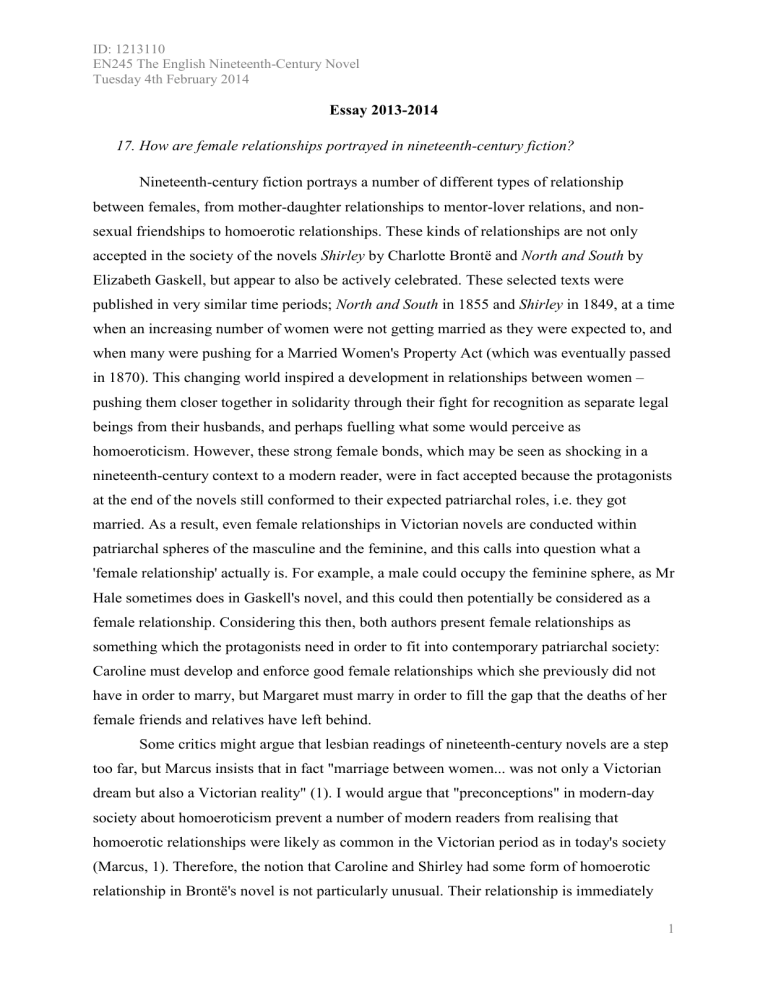
ID: 1213110
EN245 The English Nineteenth-Century Novel
Tuesday 4th February 2014
Essay 2013-2014
17.
How are female relationships portrayed in nineteenth-century fiction?
Nineteenth-century fiction portrays a number of different types of relationship between females, from mother-daughter relationships to mentor-lover relations, and nonsexual friendships to homoerotic relationships. These kinds of relationships are not only accepted in the society of the novels Shirley by Charlotte Brontë and North and South by
Elizabeth Gaskell, but appear to also be actively celebrated. These selected texts were published in very similar time periods; North and South in 1855 and Shirley in 1849, at a time when an increasing number of women were not getting married as they were expected to, and when many were pushing for a Married Women's Property Act (which was eventually passed in 1870). This changing world inspired a development in relationships between women – pushing them closer together in solidarity through their fight for recognition as separate legal beings from their husbands, and perhaps fuelling what some would perceive as homoeroticism. However, these strong female bonds, which may be seen as shocking in a nineteenth-century context to a modern reader, were in fact accepted because the protagonists at the end of the novels still conformed to their expected patriarchal roles, i.e. they got married. As a result, even female relationships in Victorian novels are conducted within patriarchal spheres of the masculine and the feminine, and this calls into question what a
'female relationship' actually is. For example, a male could occupy the feminine sphere, as Mr
Hale sometimes does in Gaskell's novel, and this could then potentially be considered as a female relationship. Considering this then, both authors present female relationships as something which the protagonists need in order to fit into contemporary patriarchal society:
Caroline must develop and enforce good female relationships which she previously did not have in order to marry, but Margaret must marry in order to fill the gap that the deaths of her female friends and relatives have left behind.
Some critics might argue that lesbian readings of nineteenth-century novels are a step too far, but Marcus insists that in fact "marriage between women... was not only a Victorian dream but also a Victorian reality" (1). I would argue that "preconceptions" in modern-day society about homoeroticism prevent a number of modern readers from realising that homoerotic relationships were likely as common in the Victorian period as in today's society
(Marcus, 1). Therefore, the notion that Caroline and Shirley had some form of homoerotic relationship in Brontë's novel is not particularly unusual. Their relationship is immediately
1
ID: 1213110
EN245 The English Nineteenth-Century Novel
Tuesday 4th February 2014 established through the introduction of an animal: a "rather large, strong, and fierce-looking dog" comes between Shirley and Caroline upon their first meeting, creating a relationship which involves some kind of animalistic, as well as natural, instinct (Brontë, 157). Brontë's initial description of Shirley is not only put in comparison with Caroline ("She was not a blonde, like Caroline") but establishes Shirley as a masculine character, who, being an only child, had "bestowed on her the same masculine family cognomen they would have bestowed on a boy" (Brontë, 158). The fact that too, the novel has been named after Shirley rather than the protagonist Caroline, has weighted a significant amount of almost-masculine expectation on the title character, especially because she does not appear until approximately a third of the way through the novel. This brings up the question then as to why the novel is named after Shirley rather than Caroline, considering the narrative is mainly centred on Caroline's life. This is firstly to make a point about gender – most Victorian novels seem to be named after houses, or men (for example, Shelley's Frankenstein is named after a man, despite the author's arguments about gender in the novel, and Shelley being female herself) – by implying women need to be focused on more in nineteenth-century texts than they previously had been. Of course, Brontë also named the novel after Shirley to demonstrate how important their relationship is to Caroline, in shaping not only the life of the protagonist but in producing the patriarchal outcome of the story.
Furthermore, if the relationship between Caroline and Shirley is to be analysed as potentially lesbian, the notion of what a 'lesbian' actually is needs to first be established.
Although on many occasions the pair refer to each other as being friends, for example when
Caroline says to Shirley: "I don't wish to leave you. I shall never find another friend so dear",
Marcus reminds modern readers that their own meaning of 'friend' is actually completely different to the Victorians' understanding of the word (Brontë, 189). She says that despite the constraints of a patriarchal society, women had "room to roam" within female relationships, and this is mainly because the word 'friend' was not very clearly defined in the Victorian period: "The lesbian was not a distinct social type during the years 1830 to 1880" and they had no particular label (Marcus, 27; 6). The definition of 'friend' before the nineteenth century was, according to Marcus, a "capacious term" which included "kin, patrons, neighbours, and spouses, along with freely chosen confidantes to whom one was not bound by blood, political obligations, physical proximity, or sexual intimacy", which essentially is a wide variety of people who one likes, whether connected to them sexually or not (26). Due to the conservative nature of the Victorians, and the lack of sexual activity depicted in Victorian
2
ID: 1213110
EN245 The English Nineteenth-Century Novel
Tuesday 4th February 2014 fiction: "If firsthand testimony about sex is the standard for defining a relationship as sexual, then most Victorians never had sex", it is very difficult to discern even "oblique references to sex between husband and wife" in the text, let alone between women (Marcus, 43). For example, even at the end of the novel when Caroline marries Robert and Shirley marries
Louis, Brontë makes no reference to the consummation of either marriage. Therefore, as even the marriages in the novel are not defined as sexual, it would be incorrect to define Shirley and Caroline's relationship as 'homosexual'. Instead, the relationship between the two women should be described as inherently homoerotic as it is suggested, even through their initial introduction of a dog representative of animalistic desire, that there is something more than a typical friendship (as defined in modern terms) between them. For example, Shirley claims to
Caroline that "he [Robert] keeps intruding between you and me" (Brontë, 206).
Although some would believe that Brontë is being very forward-thinking with this introduction of a homoerotic relationship between two women, Marcus argues that actually
"lesbian relationships enjoyed an unexpected degree of knowing acceptance", for example, even the archbishop of Canterbury invited his wife's lover to live in their family home
(Marcus, 31). In the same way, when Mrs Pryor asks Caroline to live with her (before she reveals that she is Caroline's mother): "I could not endure to live in solitude", Caroline accepts the suggestion as if it is completely natural: "I should like to live with you" (Brontë,
302). After completion of the novel, however, one looks back on this scene with irony because of course, Caroline and Mrs Pryor do end up living together, but also with Caroline's husband, Robert. It appears then that these kinds of intimate relationships between women are acceptable, but only if they fit into the expectations of patriarchal society.
Despite being described as homoerotic, the novel's "frequent identification of Shirley with masculinity" in her relationship with Caroline in fact easily conforms their relationship to patriarchal roles (Marcus, 99). For example, their relationship fits with Menon's theory of the mentor-lover, which although is applied to male-female relationships in this criticism, also applies to a masculine-feminine relationship between two females. Menon argues that the novel is all about power and says that "the role of sexuality in these 'relations of power' could certainly be traced out in Shirley " (109). Shirley certainly appears to be in control of
Caroline; she is described at certain points in the novel as a "lioness", "leopardess" and a
"pantheress" (Brontë, 477; 492; 497). Masculine traits of Shirley are further littered throughout the novel, such as having a "penetrating eye" and "eyes of the darkest grey... transparent, pure, neutral grey" (Brontë, 205; 158). Even when the pair spend the night
3
ID: 1213110
EN245 The English Nineteenth-Century Novel
Tuesday 4th February 2014 together, "we occupied the same room and bed. We did not sleep much", Shirley appears to have some kind of agenda to this conversation with Caroline – they "talked the whole night through" about Robert (Brontë, 474). By taking this kind of control then Shirley becomes a mentor to Caroline, by being the more dominant character to give advice and plan things, such as when an attack on the mill is imminent and Shirley says: "My eyes and ears are wide open... you shall be under surveillance. Be you vigilant also, Lina" (Brontë, 248). The effect of Shirley being dominant, and therefore residing in the masculine sphere, is the reason why her intimate relationship with Caroline is deemed 'acceptable' in Victorian society. Marcus suggests that "women in female couples continued to use marriage as a model for their relationships", and in this way Brontë creates a butch-femme relationship between Shirley and Caroline, resembling that of heterosexual couples (6).
While Brontë portrays a butch-femme relationship as acceptable because it fits into a patriarchal model, she is also critiquing this idea by conveying elements of femininity in
Shirley's character. These elements appear to be attempting to break through her constraints of masculinity, for example when she "made a commotion that might have become the most delicate and nervous of her sex" (Brontë, 244). Moreover, in a more complex way Brontë is introducing these feminine traits in order for Shirley to take the feminine role in her eventual marriage to Louis, producing a butch-femme dichotomy in the character of Shirley herself.
This contradiction supports Poovey's argument that the "organisation of sexual relations are social, not natural, phenomena" in Victorian society, as of course Shirley's oscillation between masculine and feminine is not natural; it just slots her into different social spheres
(2). Brontë is therefore indicating that although heterosexual patriarchy is a model for female relationships in Victorian fiction, she does not necessarily support it because it is false and unnatural.
On the other hand, Gaskell produces a completely different kind of 'female relationship' in North and South ; the loss of which pushes protagonist Margaret to conform to a typical patriarchal marriage. Stoneman claims that Margaret's father, Mr Hale, is
"feminised" in the chapter entitled "Masters and Men" as he argues with Margaret against Mr
Thornton, who is all business: "We Milton masters have to-day sent in our decision. We won't advance a penny" (138; Gaskell, 128; 137). Mr Hale takes more of a sympathetic view, which would be classed as typically feminine in a Victorian society, looking at the human side of the situation rather than from a business perspective: "I dare say I am talking in great ignorance; but, from the little I know, I should say that the masses were already passing
4
ID: 1213110
EN245 The English Nineteenth-Century Novel
Tuesday 4th February 2014 rapidly into the troublesome stage which intervenes between childhood and manhood"
(Gaskell, 141). As in Brontë's novel even the female relationships are modelled on patriarchal butch-femme roles, one may question why then Mr Hale is feminised in North and South , going against traditional patriarchal roles. I would insist that the reason Gaskell feminises Mr
Hale is because he is required to step into the feminine role of mother to Margaret, when her own mother is absent through illness and consequential death. Furthermore, the workingclass men in the mill are also feminised in the novel; Stoneman argues that men "work together with their womenfolk rather than seeing the care of children as a 'separate sphere'"
(138). This is again likely due to the absence of female characters in the novel through their deaths. However in doing so, Gaskell appears to be ironically reflecting the results of the
1851 Census, which Poovey said calculated "that 42 percent of the women between the ages of twenty and forty were unmarried", resulting in there being "too many women" for the proportion of unmarried men in society (4, 5). By reversing this statistic and placing too many men in feminised roles, Gaskell actually demonstrates that Margaret needs to get married, in order to restore balance in a society based on socially-created phenomena and remasculinise the men in the novel.
Whereas the title character Shirley is the masculinised character in Brontë's novel, in
Gaskell's North and South the protagonist Margaret is masculinised, which is likely why some of the male characters in the novel, particularly her father, appear feminine. For example, Margaret is the person having to console Mr Hale over the illness of her mother, when traditionally one would expect the parent to console the child: "Mr Hale began about his wife's health, with a kind of veiled anxiety... She [Margaret] put the truth plainly and strongly" (Gaskell, 128). Stoneman claims that "Margaret's notion of the feminine role is energetic and self-reliant", which many would perceive as masculine because she takes control in situations when her father will not (138). Margaret's unusual amount of control (for a woman in contemporary Victorian times) is established even right at the beginning of the novel, when she is "better-informed" than her mother, and has to explain Mr Hale's decision to move away to Mrs Hale (Gaskell, 49). The reason why Margaret has this added selfassurance and masculinity that Caroline does not is because Margaret is "forced by necessity" to take control of her family when it is struck by unfortunate circumstances, like illness and having to move across the country (Stoneman, 138). Because of this necessity, Margaret
"constitutes a startling excursion into the public sphere" and is forced to mix with people from different classes, such as Bessy and Nicholas Higgins (Stoneman, 138).
5
ID: 1213110
EN245 The English Nineteenth-Century Novel
Tuesday 4th February 2014
Caroline on the other hand is less exposed to people of different classes because she is defined by the domestic sphere of her uncle, who does not understand, or chooses not to understand, women: "He [Mr Helstone] thought, so long as a woman was silent, nothing ailed her, and she wanted nothing" (Brontë, 39). Due to her restrictions Caroline is more insecure than Margaret about ending up unmarried for the rest of her life; she sees the tasks women are expected to do, such as sewing, dull and monotonous: "Her brain worked faster than her fingers... more intensely than ever, she desired a fixed occupation" (Brontë, 187). In this way then it is clear that Caroline requires female relationships, particularly the one with Shirley, to help free her from her uncle's domestic sphere and guide her towards some kind of fixed occupation, i.e. marriage. Margaret however loses all of her female relationships in North and
South , including Bessy, her mother and her father (if he is considered to be feminine), therefore she needs to get married so she can channel the energies she previously based on her own family into a new family.
Moreover, the backgrounds of the authors of North and South and Shirley give a little insight into their own perceptions of female relationships and the patriarchy, and this is likely translated into their texts. Gaskell appears to be less critical than Brontë, if at all critical, of women's occupations such as sewing and cooking. Most of Gaskell's novels were published under the title of 'Mrs Gaskell' until fairly recently, making her "self-evidently a wife and... the mother of four daughters" (Stoneman, 132). This is obviously because Gaskell was supportive of traditional marriage, and wished the reader to be clear about this upon starting the novel. The use of 'Mrs' acts as a statement which suggests she is "far from feeling oppressed by the patriarchal family", therefore when interpreting female relationships in the novel one must always consider that they likely fit back into patriarchal spheres in some form, owing to Gaskell's beliefs (Stoneman, 133). The difference between these two selected texts – that Brontë presents female relationships as compulsory to lead Caroline to a life of marriage, and that Gaskell portrays marriage as compulsory to replace the female relationships that Margaret has lost – is largely explained through Charlotte Brontë's background: "The childless Brontë sisters felt more acutely than Gaskell the lack of purpose and opportunity in women's lives" (Stoneman, 132). Interestingly though, Brontë does not choose first-person narration for Shirley like in her two most well-known novels Jane Eyre and Villette – she opts for third-person narration, likely so readers can draw their own conclusions about the impact of female relationships on marriage. Although Gaskell also uses a third-person narration, her omniscient narrator occasionally interjects with opinion, for
6
ID: 1213110
EN245 The English Nineteenth-Century Novel
Tuesday 4th February 2014 example: "He [Mr Thornton] was no great analyser of his own motives, and was mistaken, as
I have said" (Gaskell, 283). This gives Gaskell a little more freedom to express her own (or the narrator's) support for female roles in the patriarchy, such as calling Margaret's sewing
"flimsy, useless work" through Mrs Thornton in a form of free indirect speech, as if to suggest that without being good at sewing, Margaret has little use in her own domestic sphere
(Gaskell, 111). Brontë however felt she needed to give Caroline more of a purpose through female relationships with both Shirley and her mother, Mrs Pryor, before allowing Caroline to enter patriarchal marriage. Brontë believed in marriage, but only if she believed it was right and appropriate; and unlike Gaskell, she did not see sewing and cooking as tasks suitable enough to occupy the time of women.
Considering the authors of both texts clearly endorse marriage because their protagonists get happily married at the end of the novels, neither Brontë nor Gaskell portray marriage in a particularly conventional way. Brontë certainly conveys marriage in a more unconventional way than Gaskell, who admits that "[t]he difference between Miss Brontë and me is that she puts all her naughtiness into her books, and I put all my goodness" (qtd. in
Stoneman, 133). Gaskell only allows the one marriage at the end of North and South ; Brontë, on the other hand, introduces a strange, almost incestuous four-way marriage. Marcus argues that the use of marriage in the novel "equates heterosexuality with the real" because although of course homosexual or homoerotic relationships are real, two members of the same sex cannot legally get married (74). In this way then, because heterosexuality is made "the only acceptable mode of desire", homoeroticism is 'corrected' by the institution of marriage
(Marcus, 75). Marcus argues that "critics have tended to read the novel's final marriages as reinstating the hierarchies challenged earlier on in the plot", however, I would disagree with this suggestion of finality in the marriages at the end of Shirley, due to their duplicities (96).
Not only is there a very clear double marriage plot when "Caroline Helstone and Shirley
Keeldar both become Mrs Moore" and they marry brothers, which gives "linguistic form to the social bond they have already created with each other", but Brontë appears to be suggesting that the two Mrs Moores have symbolically married each other (Marcus, 96).
Therefore although Brontë does support traditional marriage, this rejects John Gillis' idea that
"by the nineteenth century, the married couple existed in opposition to the collective world of friends", as the name bond between Shirley and Caroline suggests that the two will remain close friends (as they become sisters-in-law) past the time that the novel ends (Marcus, 29).
Instead, this supports Marcus' argument that, whether homoerotic or not, "female friendships
7
ID: 1213110
EN245 The English Nineteenth-Century Novel
Tuesday 4th February 2014 peaceably coexisted with heterosexual marriages and moreover, helped to promote them" (2).
Brontë saw female relationships as both intrinsic to and compulsory for a healthy and happy married life.
The other marriage plot in Brontë's Shirley is between Caroline and her mother, Mrs
Pryor. When Mrs Pryor asks Caroline to live with her, as discussed earlier in this essay, it could easily be interpreted as a marriage proposal; the scene in chapter 21 takes place "in the shade of unmolested trees" in a woodland of "brushwood and stunted oaks", the wood being a traditional representation of unrestrained female sexuality (Brontë, 294). Mrs Pryor also "bent her head to her knee" as if in proposal and then ends up living in the marital home with
Caroline and Robert and "her own rooms and servant", almost as if she has created her own marital home with Caroline (Brontë, 302; 507). As well as the mother-daughter marriage there is the brother-brother marriage between Louis and Robert; there end up being two Mr
Moores and two Mrs Moores by the end of Shirley . This slightly incestuous, quadruple connection between the main characters in the novel stresses the importance Brontë places on family members, and female relationships in particular: most probably due to the tragic family losses Brontë encountered during her writing of the novel.
Both authors present that a woman's position is what will pave the way towards her marriage, and further, a happy ending. For example, Caroline's position of having good relationships with both her mother and Shirley pushes her towards marriage with Robert; the narrative requires Shirley to reject him before he proposes to Caroline. In Gaskell's North and
South though, it is the position of Margaret considered in the context of women in the nineteenth century which moves her towards a marriage. Wynne suggests that the
"performance of ownership", i.e. being able to say one owns something, is important to a woman's relationship with the world, and this can also be extrapolated to women's relationships in general (6). In Gaskell's novel, "painful moments of realisation of women's dispossessed state" are scattered through it, for example, the lack of furniture in Margaret's new home in Milton represents a larger gap of belonging in her life: "It needed more – more that could not be had" (Wynne, 9; Gaskell, 74). Margaret's state of dispossession (or more, disorientation of belonging from south to north, such as being called a "foreigner" by
Nicholas Higgins) reflects the lack of belonging Caroline feels in Shirley , however Caroline is lacking purpose through being controlled by her uncle, rather than feeling uncertain about the conventions of a different geographical location (Gaskell, 84).
8
ID: 1213110
EN245 The English Nineteenth-Century Novel
Tuesday 4th February 2014
As the plot of Brontë's novel progresses, Caroline finds a purpose through the female relationships she develops. However, Margaret's feeling of emptiness in Gaskell's text simply increases after the loss of her mother, her most treasured female relationship: she goes through a "chapter of unspeakable consolation" and is "continually blinded with tears"
(Gaskell, 297; 298). Yet when Margaret is given an inheritance, this gives her purpose to fill the gap a loss of female relationships has created, and encourages her to get married – although this has more of an agenda than it first appears. Wynne notes that "until the passing of the Married Women's Property Act in 1870, wives were prohibited under common law from owning property", therefore, if Margaret were to marry and go through a dispossession process once again, she should at least invest it into something, in this case, the Marlborough
Mills (6). The idea of marriage and further dispossession at the end of North and South may seem very backward, as Margaret would be giving up her new-found possessions, Gaskell actually modernises Margaret's experience by turning her into something of a businesswoman. She says to Mr Thornton that her money is "lying just at this moment unused in the bank, and bringing me in only two and a half percent – you could pay me much better interest" (Gaskell, 519). In this way then the loss of Margaret's female relationships in the novel, namely those of her mother and father, allows the inheritance to be passed onto her and thus helps her become an independent businesswoman, even within a marriage. Female relationships in Gaskell's novel are thus seen as encouraging progression.
The importance too of mother-daughter relationships in Shirley and North and South cannot be emphasised enough. As Caroline gains a mother figure, and Margaret loses a mother figure, the two can be directly compared as both experiences make the respective characters stronger. The love that Margaret and her mother have for one another is emphasised right from the beginning of the novel, where the narrator notes that "her mother
[was] always so kind and tender towards her" and demonstrates that Margaret clearly has a lot of respect for her mother, by explaining her father's life-changing plans: "When the bee flew forth... she would begin" (Gaskell, 16; 48). It is clear from this closeness in both emotion and conversation that Margaret's relationship with her mother is very important to her, and interestingly around the time that Mrs Hale falls ill, a "dim fear lying like a weight on her heart", is when Margaret develops a stronger relationship with Bessy – almost as if she is trying to fill the gap that Mrs Hale will leave upon her death (Gaskell, 101). In this way then, Gaskell is also demonstrating, like Brontë, the importance of female relationships in a typical Victorian woman's life.
9
ID: 1213110
EN245 The English Nineteenth-Century Novel
Tuesday 4th February 2014
There is an air of mortality too which hangs around Milton, with "heavy smoky air" which leaves Margaret in a "stupor of despair", and even Mr Hale notices it: "Margaret, I do believe this is an unhealthy place" (Gaskell, 75). The eventual death of Mrs Hale, caused by, in the opinion of her family, the move from the "soft, silvery mists" of Helstone to the "heavy fogs... where the sun could only show long dusky streets" of Milton, leaves an unresolved situation which Mr Hale struggles to cope with, and forces Margaret to become stronger and
"be working, planning, considering" – they "depended upon her" (Gaskell, 298). In a similar way, Caroline's gain of a mother increases her strength, too: even from her very first meeting with Mrs Pryor, it is clear that they have some kind of connection: "She and this lady would, if alone, have at once got on extremely well together" (Brontë, 156). Later on, when Caroline falls ill, it is the strength and faith she has in Mrs Pryor which stops her from giving up entirely and succumbing to death: "Caroline enjoyed such peaceful rest last night, circled by her mother's arms" (Brontë, 345). Therefore both Gaskell and Brontë reveal the true importance of female relationships in the nineteenth century: they are required for strength, and even survival, in order to reach their happy ending of a patriarchal marriage.
Finally, female relationships in nineteenth-century fiction which are totally platonic, which cannot be interpreted as homoerotic or homosexual in any way, are further portrayed as being important to the futures of the protagonists in North and South and Shirley . Marcus suggests that female friendships "licensed forms of agency women were discouraged from exercising with men" as they could "compete for one another, enjoy multiple attachments, and share religious fervour" (Marcus, 2). This kind of relationship occurs between Margaret and Bessy in particular in Gaskell's novel. Their friendship seems to almost form its own separate plot strand from Margaret's family relations, and Margaret seems to often jump storylines from Bessy to her mother, which reminds one of her multiple female attachments.
Margaret makes sure Bessy is clear about this, especially when Bessy implies that Margaret has no worries or concerns: "I shall go home to my mother, who is so ill – so ill, Bessy"
(Gaskell, 161). However, the pair are also very frank with one another about religion, which would likely not be encouraged between husband and wife in the nineteenth century (after all,
Mr Thornton and Margaret clash even over the strikes), with Margaret giving Bessy advice:
"Don't dwell so much on the prophecies, but read the clearer parts of the Bible" and "we shall not be judged by that poor accident, but by our faithful following of Christ" (Gaskell, 162;
177). Gaskell would have supported this friendship strongly, as it "reinforced gender roles and consolidated class status", with Margaret's advice to and care for Bessy supporting the
10
ID: 1213110
EN245 The English Nineteenth-Century Novel
Tuesday 4th February 2014 role she will later take as a wife (Marcus, 26). The friendship clearly defines class differences, such as when Margaret offers to go and visit the Higgins family: "It seemed all at once to take the shape of an impertinence on her part; she read this meaning too in the man's eyes" (Gaskell, 84).
The chapter entitled "Old Maids" in Shirley is also significant to the idea of friendship influencing the outcome of the novel. Despite Caroline's preconceptions that she was "certain old maids are a very unhappy race", she actually comes to respect maids Ainley and Mann very much: "She discovered so much goodness, so much usefulness, so much mildness, patience, truth" (Brontë, 131; 139; 145). Brontë sends Caroline on this journey of discovery about old maids, not only to demonstrate that her preconceptions can be wrong (which later will help in her decision to forgive and marry Robert), but to allow her to explore the idea of being a single woman for the rest of her life without the need to compete with these old maids: "Brontë folds female rivalry into female friendship" (Marcus, 97). A friendship with the old maids further acts as a reminder to Caroline that she does not want to end up alone and outside the patriarchal sphere: "She still felt with pain that the life which made Miss
Ainley happy would not make her happy" (Brontë, 146).
In conclusion, authors Gaskell and Brontë, in their respective nineteenth-century novels North and South and Shirley , portray female relationships as a necessary component in guiding a woman towards a traditional patriarchal marriage, but neither author approaches female relationships in a traditional way (particularly Brontë). The authors open up a variety of different female relationships along a spectrum in their texts, such as friendships, homoerotic relationships and mentor-lovers, which on a number of occasions struggle to take distinct and separate forms. This is owing to the lack of clear definition about the word
'friend' in Victorian society, and also due to the conservative nature of contemporary authors in describing sexual activity, which is never made explicit. Although Caroline's potential of a homosexual relationship with Shirley appears to be 'corrected' by her eventual marriage at the end of the novel, Brontë ensures that the importance of female relationships is stressed by creating a four-way marriage. This further suggests how important developing solid female relationships is in encouraging Caroline to conform to the patriarchy, rather than allowing her to be a governess for the rest of her life. In Gaskell's novel, a friendship with Bessy helps
Margaret develop qualities suitable in a typical Victorian wife, however, not only does the loss of female relationships with both her mother and father encourage her to create her own family, but makes her strong enough to do this on her own terms. So despite female
11
ID: 1213110
EN245 The English Nineteenth-Century Novel
Tuesday 4th February 2014 relationships appearing to be dragged back into the patriarchy and hardly breaking out of their spheres at all, both writers make small successes. Brontë portrays the acceptability of a homoerotic relationship in nineteenth-century society by providing a female-female marriage
(although Brontë frames Shirley as unnaturally masculine in the female relationship, to demonstrate her dissatisfaction with traditional patriarchal spheres) and Gaskell portrays
Margaret as an independent part of her marriage, rather than being defined by her husband.
Admittedly it is disappointing that neither author goes further in encouraging their protagonist to use female relationships to break out of the patriarchal sphere entirely – particularly considering the changing situation of contemporary women when they are fighting for legal recognition – but the slight deviations seen already demonstrate that "in the past as in the present, marriage and family, gender and sexuality, are far more intricate, mobile, and malleable than we imagine them to be" (Marcus, 262).
Word count: 5,249
12
ID: 1213110
EN245 The English Nineteenth-Century Novel
Tuesday 4th February 2014
Works Cited
Brontë, Charlotte. Shirley . London: J.M. Dent & Sons Ltd., 1949.
Gaskell, Elizabeth. North and South . London: Penguin Books, 1855.
Marcus, Sharon. Between Women . Princeton and Oxford: Princeton University Press, 2007.
Menon, Patricia.
Austen, Eliot, Charlotte Brontë and the Mentor-Lover
. New York: Palgrave
Macmillan, 2003.
Poovey, Mary. Uneven Developments . Chicago: University of Chicago Press, 1988.
Stoneman, Patsy. "Gaskell, Gender, and the Family." The Cambridge Companion to Elizabeth
Gaskell . Ed. Jill L. Matus. Cambridge: Cambridge University Press, 2007. Pg 131-147.
Wynne, Deborah. Women and Personal Property in the Victorian Novel . Surrey: Ashgate Publishing
Limited, 2010.
13
